Sir John Monash, Personal Files Book 14, 1 December 1916 - 10 February 1917, Part 4
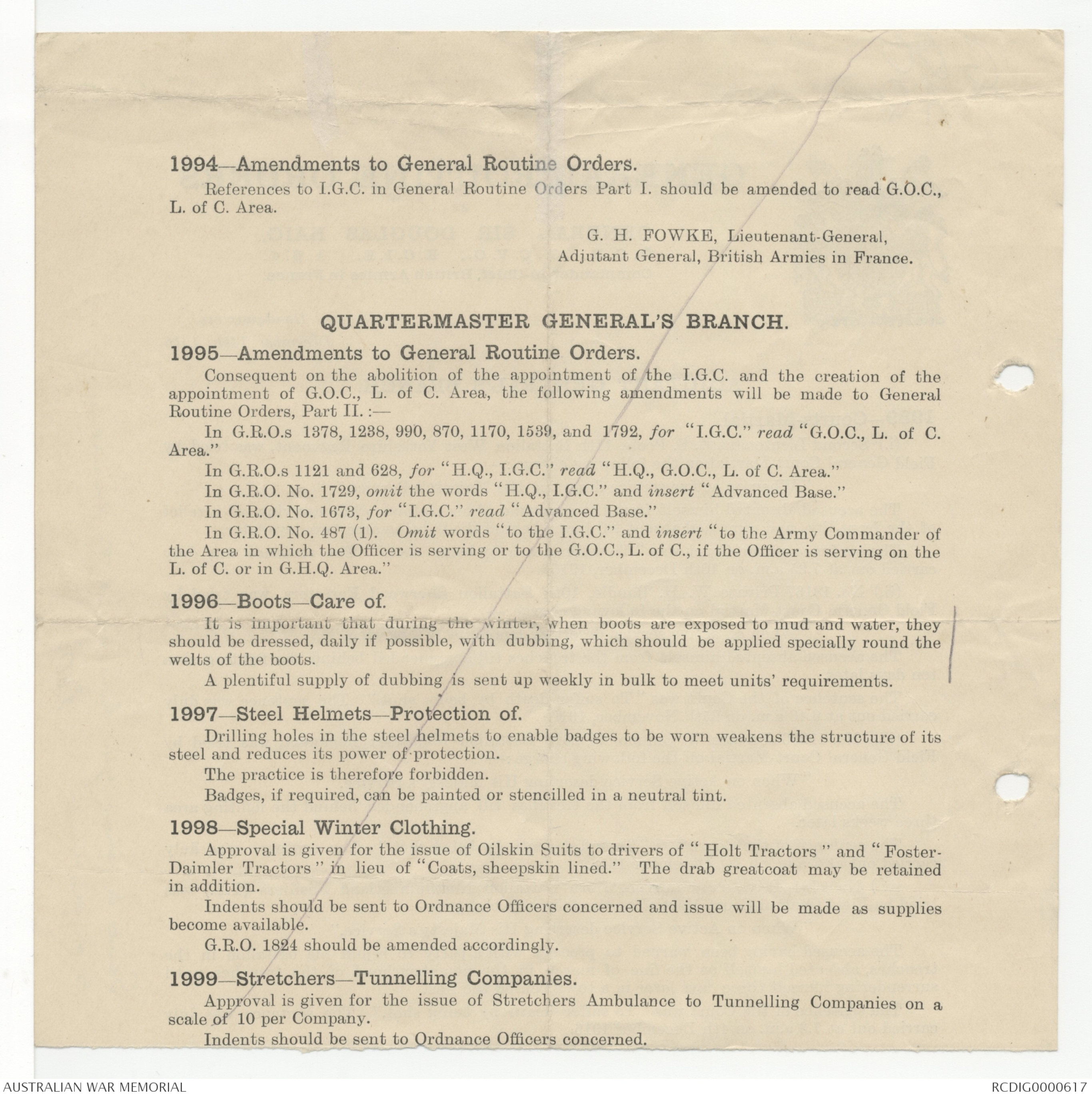

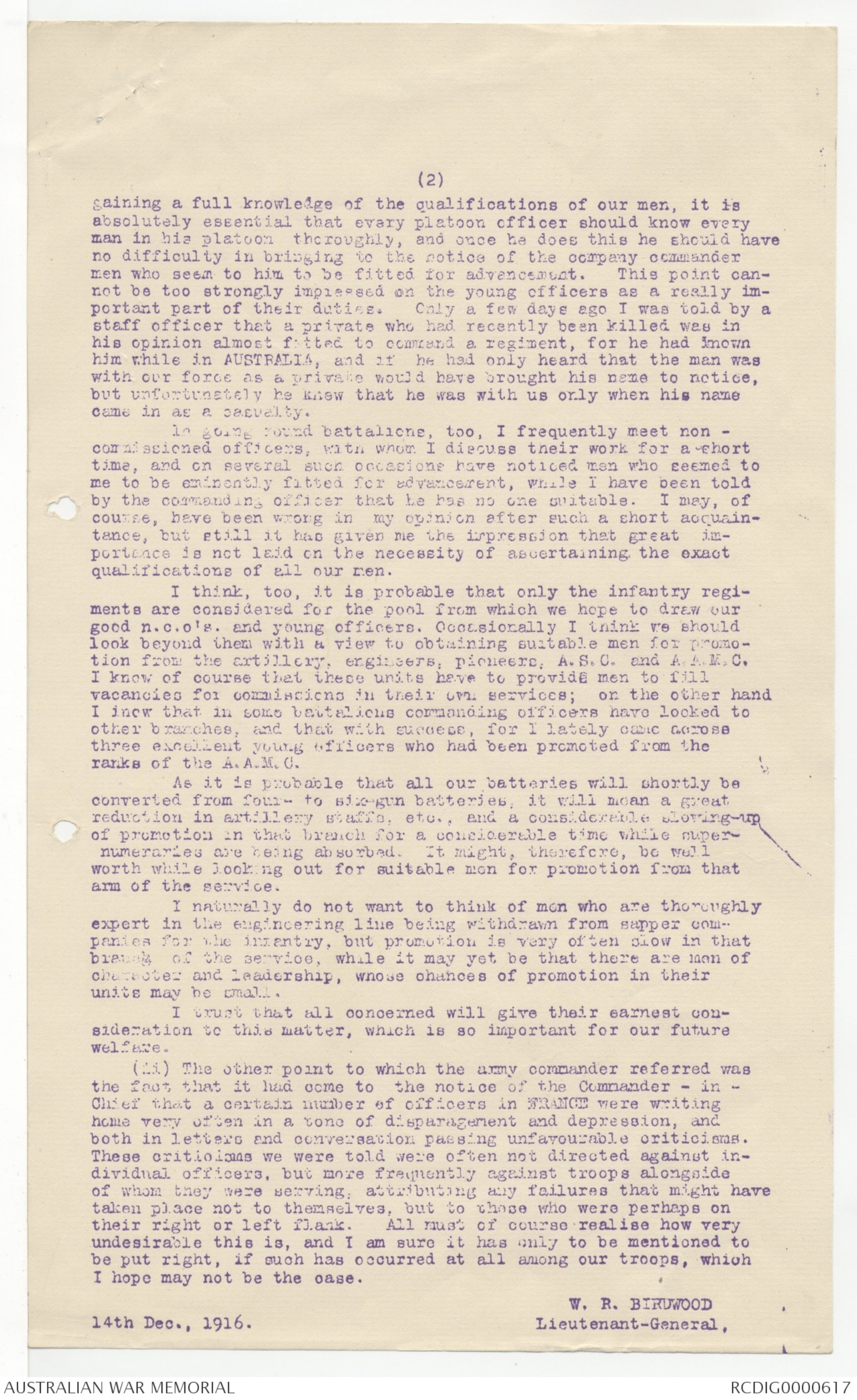
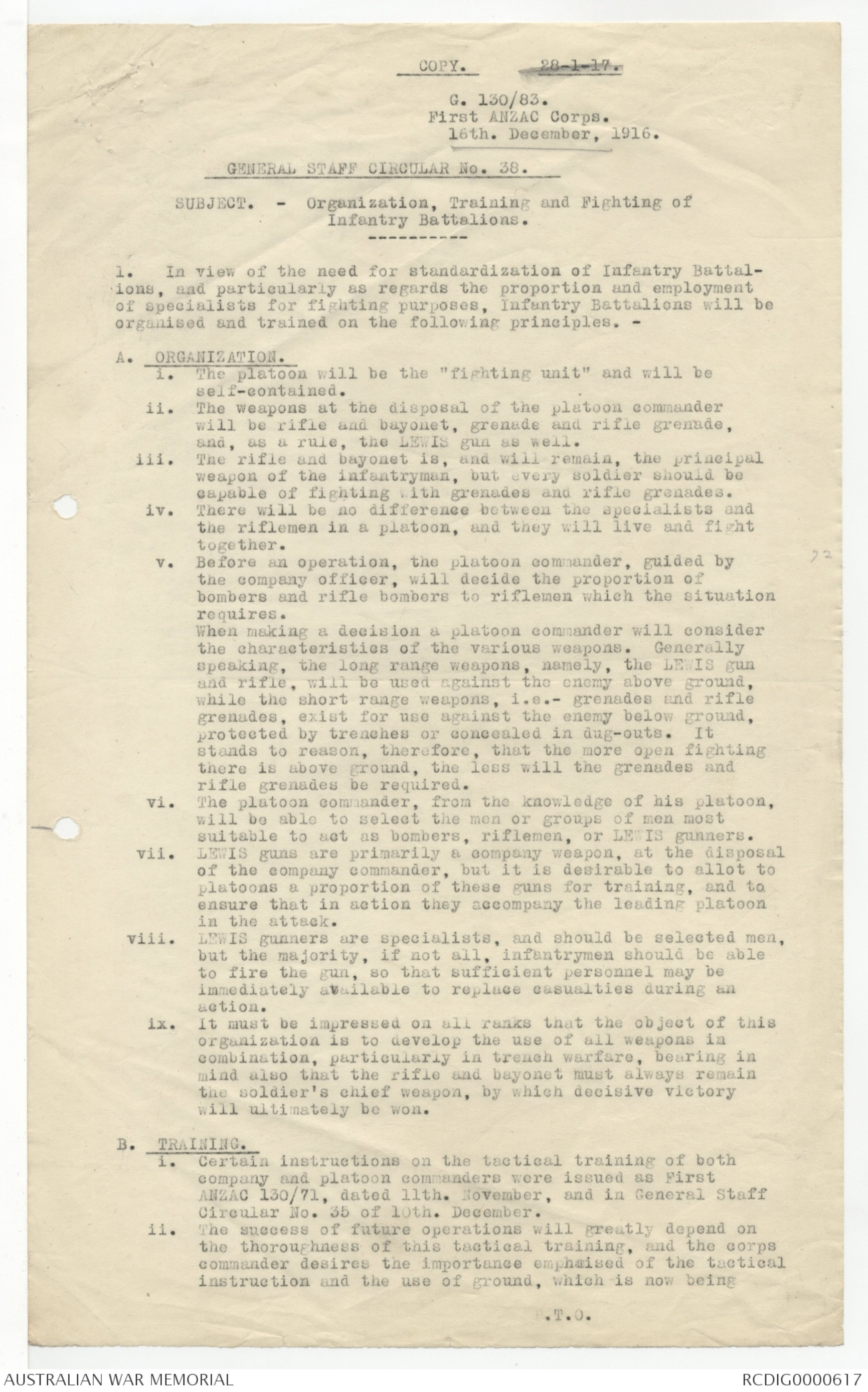
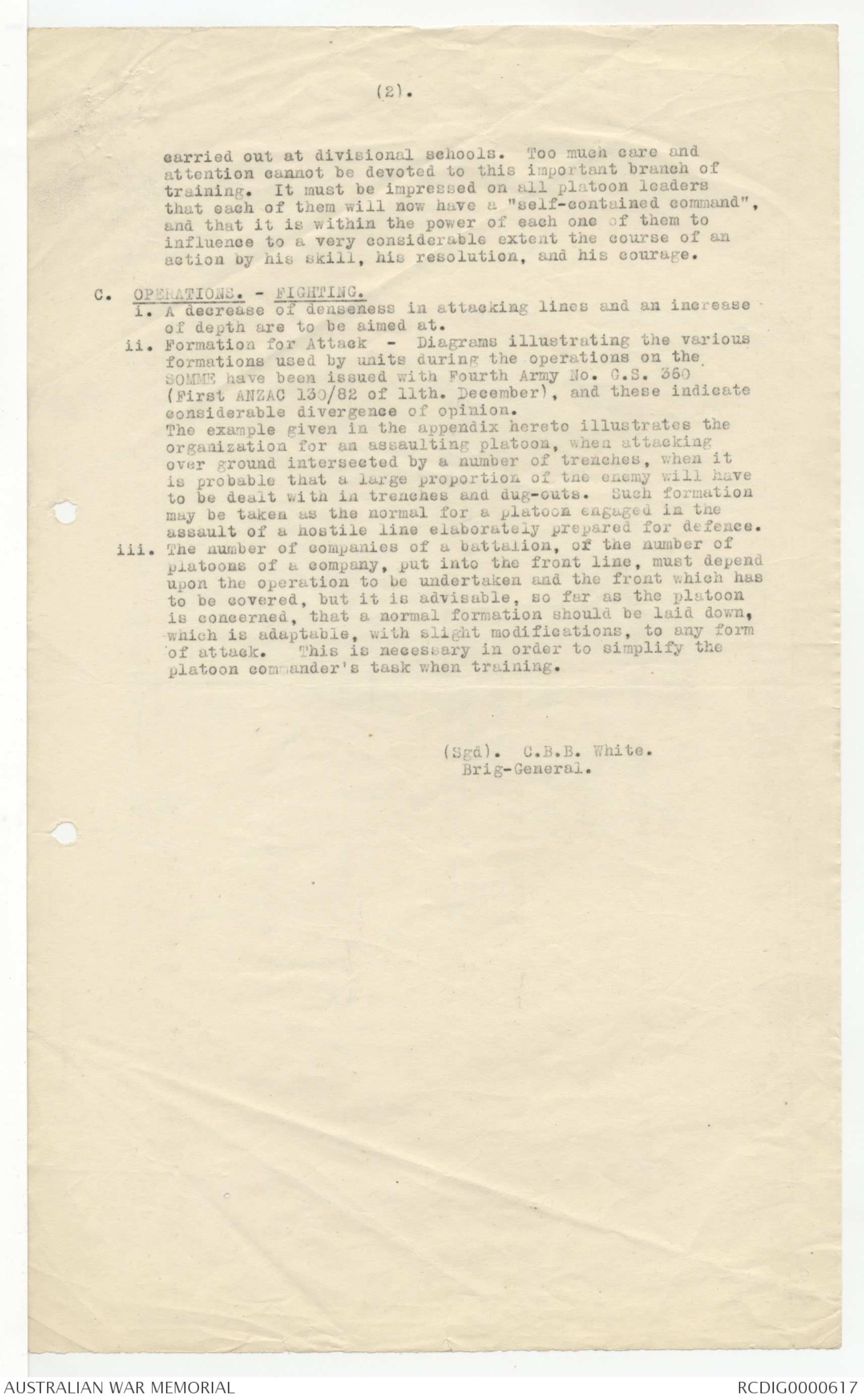
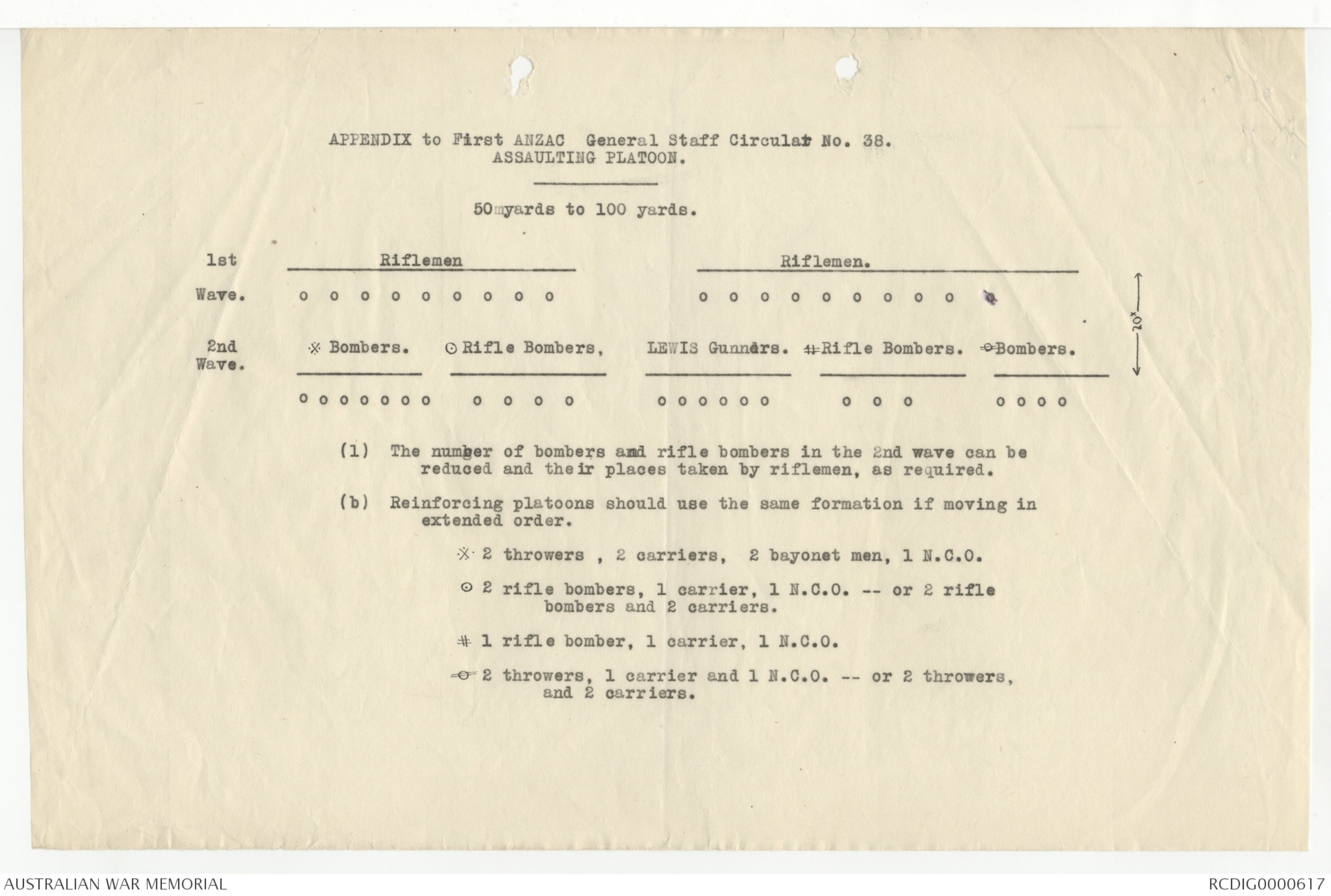
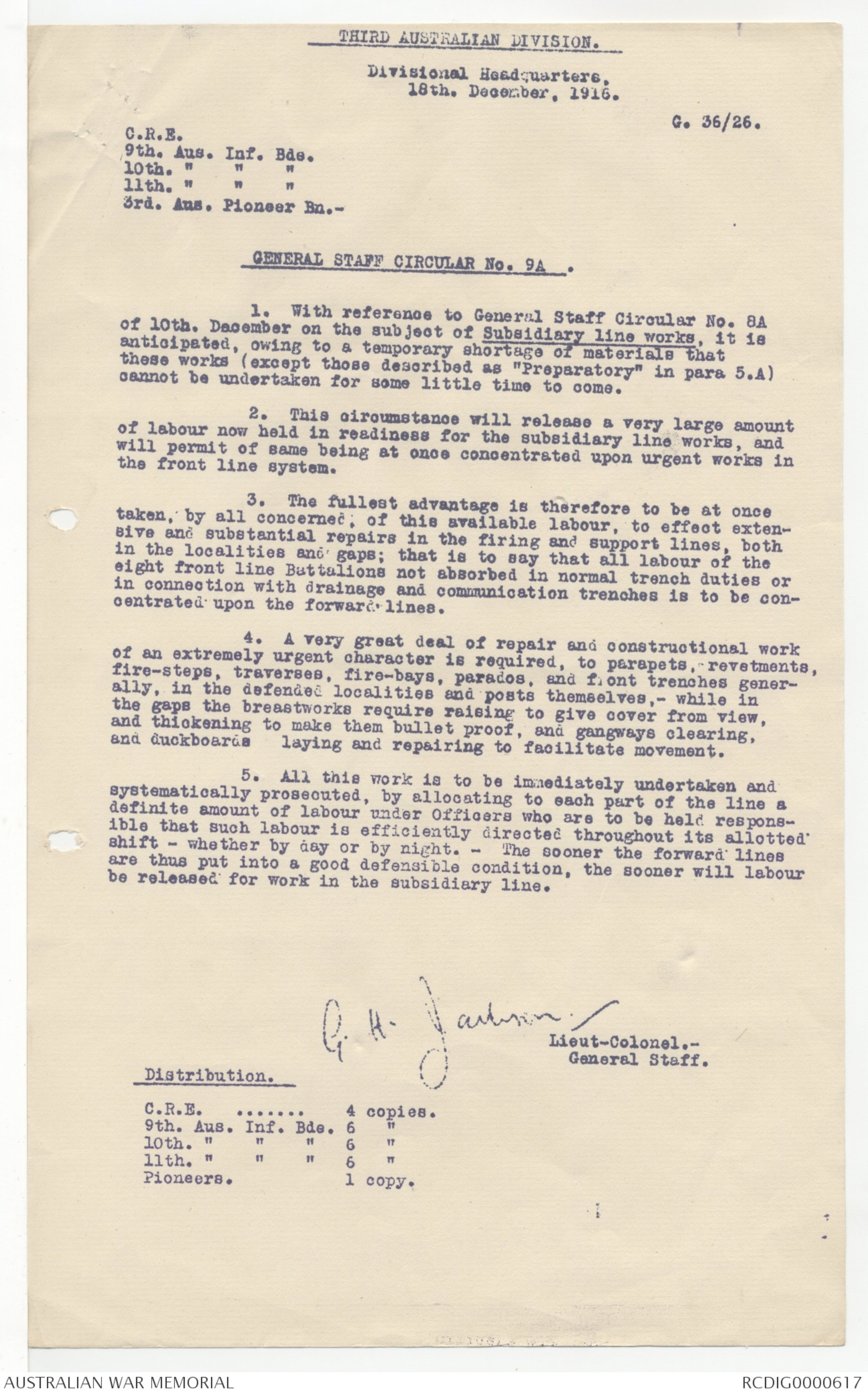
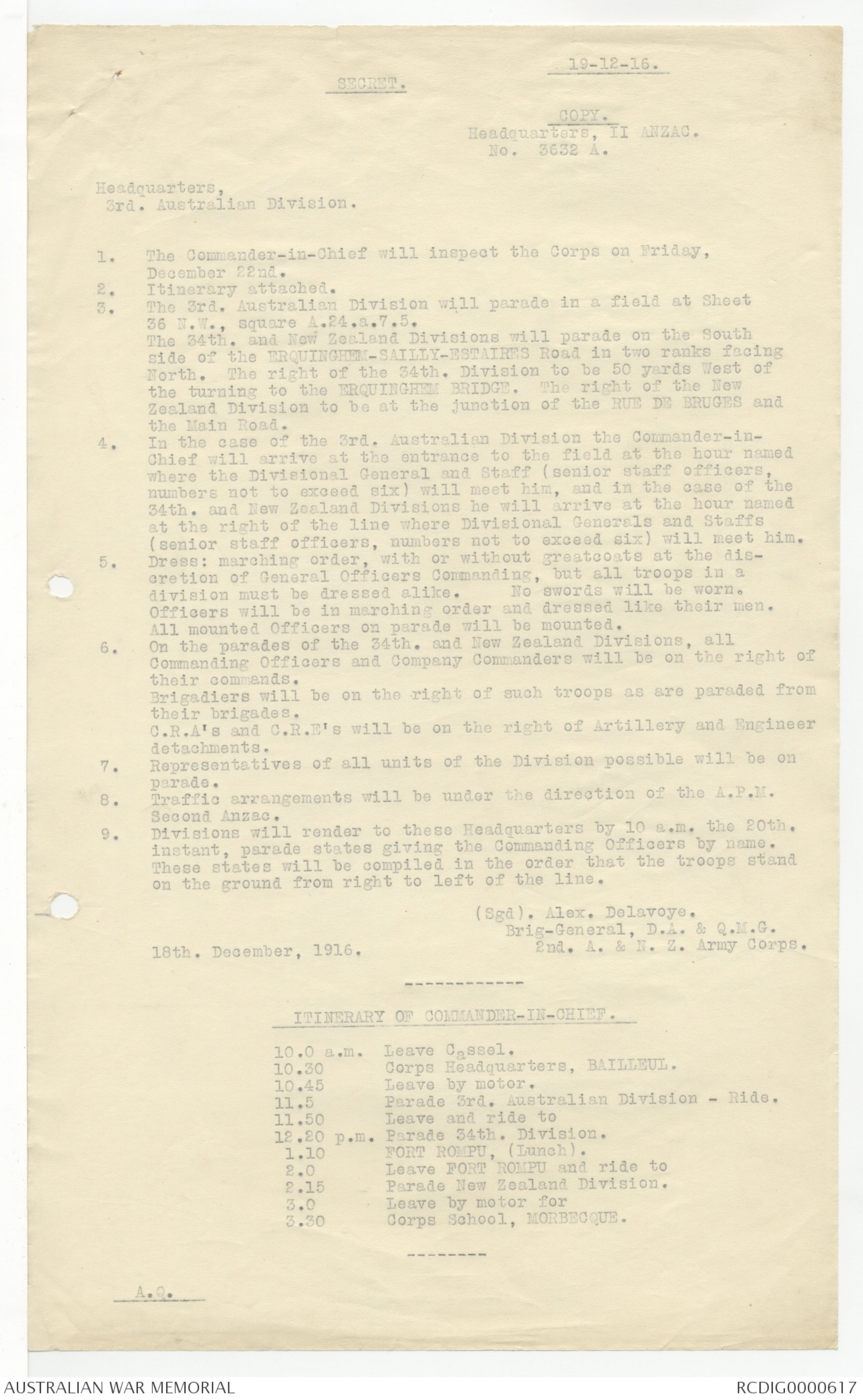
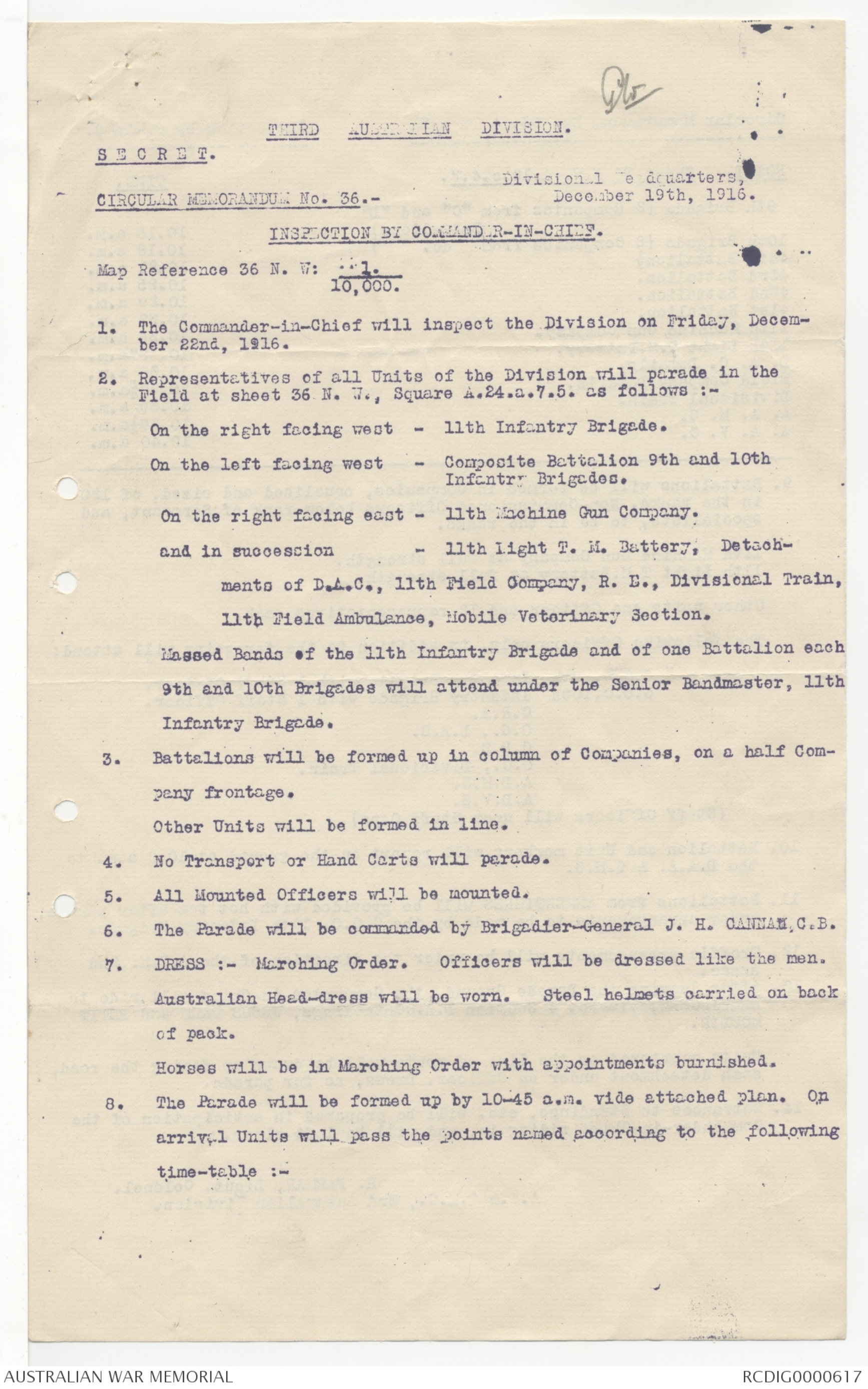
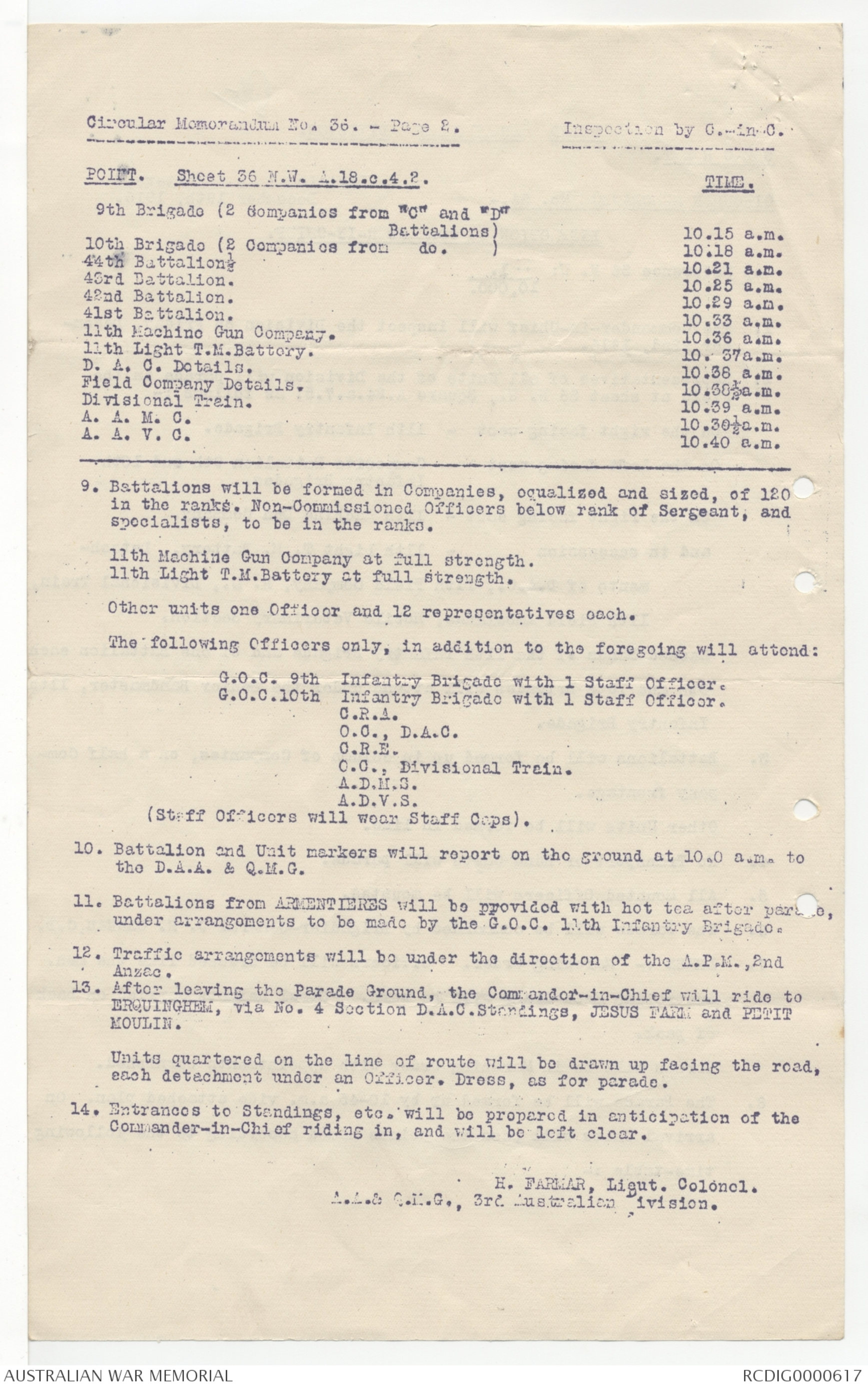
1994 - Amendments to General Routine Orders.
Reference to I.G.C in General Routine Orders Part I. should be amended to read G.O.C.,
L. of C. Area.
G.H. FOWKE, Lieutenant-General,
Adjutant General, British Armies in France.
QUARTERMASTER GENERAL'S BRANCH.
1995 - Amendments to General routine Orders.
Consequent on the abolition of the appointment of the I.G.C and the creation of the
appointment of G.O.C., L. of C. Area, the following amendments will be made to General
Routine Orders Part II,:-
In G.R.O.s 1378, 1238, 990, 870, 1170, 1539, and 1792, for "I.G.C." read "G.O.C, L. of C.
Area."
In G.R.O.s 1121 and 628, for "H.Q., I.G.C." read "H.Q., G.O.C., L. of C. Area."
In G.R.O No. 1729, omit the words "H.Q., I.G.C." and insert "Advanced Base."
In G.R.O No. 1673, for "I.G.C." read "Advanced Base".
In G.R.O No. 487 (1). Omit words "to the I.G.C." and insert "to the Army Commander of
the Area in which the Officer is serving or to the G.O.C., L. of C., if the Officer is serving on the
L. of C. or in G.H.Q. Area."
1996-Boots-Care of.
It is important that during the winter, when boots are exposed to mud and water, they
should be dressed, daily if possible, with dubbing, which should be applied specially around the
welts of the boots.
A plentiful supply of dubbing is sent up weekly in bulk to meet units' requirements.
1997-Steel Helmets-Protection of.
Drilling holes in the steel helmets to enable badges to be worn weakens the structure of
its steel and reduces its power of protection.
The practice is therefore forbidden.
Badges, if required, can be painted or stencilled in a neutral tint.
1998-Special Winter Clothing.
Approval is given for the issue of Oilskin Suits to drivers of "Holt Tractors" and "Foster-Daimler
Tractors" in lieu of "Coats, sheepskin lined." The drab greatcoat may be retained
in addition.
Indents should be sent to Ordnance Officers concerned and issue will be made as supplies
become available.
G.R.O. 1824 should be amended accordingly.
1999-Stretchers-Tunnelling Companies.
Approval is given for the issue of Stretchers Ambulance to Tunnelling Companies on a
scale of 10 per Company.
Indents should be sent to Ordnance Officers concerned.
14/12/16
CONFIDENTIAL
I ANZAC Corps.
At a meeting of corps commanders held two days ago at Army
headquarters, the army commander asked that certain points in connection
with officers generally throughout the forces in France
should be especially brought to notice of divisional-generals and
those under them.
(i) It was pointed out that throughout the whole army we are
undoubtedly in a very different position from what we were two
years ago, and of course the same applies, possibly to a greater
extent, to the Germans. When we started the war, we had a large
number of thoroughly trained professional officers. Of these a
very large number has disappeared, and to a great extent had to be
replaced my men who previously knew nothing of soldiering. All
units are more of less in the same state, so that it is quite
impossible for us ever to look to the old regular army to provide
officers, and we must therefore realise that we must be
self-supporting.
Indeed, in this respect I cannot help thinking that
we are probably much better off than a great many others as we
have in the A.I.F. such a large number of young men who have
had a much wider experience than many of the boys who have joined
the New Army in ENGLAND. We have enlisted men of intelligence,
initiative and resource, and it therefore behoves us to make full
and ample use of these, and to satisfy ourselves that our resources
in this respect are not allowed to lie fallow.
When we come to further heavy fighting, we must again
expect heavy losses among officers, and it is to make good these
that we have not to look well ahead.
The army commander therefore laid great stress upon the
necessity for a thorough training in our divisional schools,
while we have the opportunity, of all young officers,
non-commissioned
officers, and aspirants to those posts, as platoon
officers and platoon sergeants. The Commander-in Chief has
said that this is a platoon officers' war, and, this being the
case, it behoves us to see that no steps are neglected to
ensure the selection of our best men for appointment as platoon
officers.
While seeing different battalions as I do, I am often
told by some commanding officers that they have excellent young
officers and non-commissioned officers, and still a number of
men in the ranks who they have reason to suppose will train on
satisfactorily in time to replace casualties. In other battalions
I am told that they are absolutely at their last gasp
in this respect - that every eligible man has been promoted,
and that they have not even one man left in the ranks who is
fitted for promotion to sergeant. It may well be the case
that among older men in the ranks there are none left who are
suitable for promotion, as they will be those remaining after
sifting out time after time the fit men to replace casualties
incurred in our various engagements.
If this is the case, it must not be overlooked that
among reinforcements there must be a certain number of men
whom it will be well worth while taking in hand with a view to
their improvement and fitting them for promotion. I am aware
that in some battalions there is a dislike to promoting a
private of reinforcements (who possibly came out from AUSTRALIA
as a temporary sergeant, and who has had to revert on joining
us) over the heads of the old soldiers. If it is thought that
such a man would not be suitable as an officer in his own
battalion, his name should at once be noted, and given to the
brigadier, with a view to his possible promotion in another
battalion of the same or probably a different brigade.
To make sure, however, that we do not miss a chance of
(2)
gaining a full knowledge of the qualifications of our men, it is
absolutely essential that every platoon officer should know every
man in his platoon thoroughly, and once he does this he should have
no difficulty in bringing to the notice of the company commander
men who seem to him to be fitted for advancent. This poing cannot
be too strongly impressed on the young officers as a really important
part of their duties. Only a few days ago I was told by a
staff officer that a private who had recently been killed was in
his opinion almost fitted to command a regiment, for he had known
him while in AUSTRALIA, and if he had only heard that the man was
with our force as a private would have brought his name to notice,
but unfortunately he knew that he was with us only when his name
came in as a casualty.
In going round battalions, too, I frequently meet
non-commissioned
officers, with whom I discuss their work for a short
time, and on several such occasions have noticed men who seemed to
me to be eminently fitted for advancement, while I have been told
by the commanding officer that he has no one suitable. I may, of
course, have been wrong in my opinion after such a short acquaintance,
but still it has given me the impression that great importance
is not laid on the necessity of ascertaining the exact
qualifications or all our men.
I think, too, it is probable that only the infantry regiments
are considered for the pool from which we hope to draw our
good n.c.o's. and young officers. Occasionally I think we should
look beyond them with a view to obtaining suitable men for promotion
from the artillery, engineers, pioneers, A.S.C. and A.A.M.C.
I know of course that these units have to provide men to fill
vacancies for commissions in their own services; on the other hand
I know that in some battalions commanding officers have looked to
other branches, and that with success, for I lately came across
three excellent young officers who had been promoted from the
ranks of the A.A.M.C.
As it is probable that all our batteries will shortly be
converted from four- to six- gun batteries, it will mean a great
reduction in artillery staffs, etc., and a considerable time while super-numeraries
are being absorbed. It might, therefore, be well
worth while looking out for suitable men for promotion from that
arm of the service.
I naturally do not want to think of men who are thoroughly
expert in the engineering line being withdrawn from sapper companies
for the infantry, but promotion is very often slow in that
branch of the service, while it may yet be that there are men of
character and leadership, whose chances of promotion in their
units may be small.
I trust that all concerned will give their earnest consideration
to this matter, which is so important for our future
welfare.
(ii) The other point to which the army commander referred was
the fact that it had come to the notice of the Commander - in - Chier that a certain number of officers in FRANCE were writing
home very often in a tone of disparagement and depression, and
both in letters and conversation passing unfavourable criticisms.
These criticisms we were told were often not directed against individual
officers, but more frequently against troops alongside
of whom they were serving, attributing any failures that might have
taken place not to themselves, but to those who were perhaps on
their right of left flank. All must of course realise how very
undesirable this is, and I am sure it has only to be mentioned to
be put right, if such has occurred at all among our troops, which
I hope may not be the case.
W.R. BIRDWOOD
Lieutenant-General.
14th Dec., 1916.
COPY. 28.1.17
G,130/83
First ANZAC Corps.
16th December, 1916.
GENERAL STAFF CIRCULAR No. 38.
SUBJECT. - Organization, Training and Fighting of
Infantry Battalions.
1. In view of the need for standardization of Infantry Battalions,
and particularly as regards the proportion and employment
of specialists for fighting purposes, Infantry Battalions will be
organised and trained on the following principles. -
A. ORGANIZATION.
i. The platoon will be the "fighting unit" and will be
self-contained.
ii. The weapons at the disposal of the platoon commander
will be rifle and bayonet, grenade and rifle grenade,
and, as a rule, the LEWIS gun as well.
iii. The rifle and bayonet is, and will remain, the principal
weapon of the infantryman, but every soldier should be
capable of fighting with grenades and rifle grenades.
iv. There will be no difference between the specialists and
the riflemen in a platoon, and they will live and fight
together.
v. Before an operation, the platoon commander, guided by
the company officer, will decide the proportion of
bombers and rifle bombers to riflemen which the situation
requires.
When making a decision a platoon commander will consider
the characteristics of the various weapons. Generally
speaking, the long range weapons, namely, the LEWIS gun
and rifle, will be used against the enemy above ground,
while the short range weapons, i.e. - grenades and rifle
grenades, exist for use against the enemy below ground,
protected by trenches or concealed in dug-outs. It
stands to reason, therefore, that the more open fighting
there is above ground, the less will the grenades and
rifle grenades be required.
vi. The platoon commander, from the knowledge of his platoon,
will be able to select the men or groups of men most
suitable to act as bombers, riflemen, or LEWIS gunners.
vii. LEWIS guns are primarily a company weapon, at the disposal
of the company commander, but it is desirable to allot to
platoons a proportion of these guns for training, and to
ensure that in action they accompany the leading platoon
in the attack.
viii. LEWIS gunners are specialists, and should be selected men,
but the majority, if not all, infantrymen should be able
to fire the gun, so that sufficient personnel may be
immediately available to replace casualties during an
action.
ix. It must be impressed on all ranks that the object of this
organisation is to develop the use of all weapons in
combination, particularly in trench warfare,m bearing in
mind also that the rifle and bayonet must always remain
the soldier's chief weapon, by which decisive victory
will ultimately be won.
B. TRAINING.
i. Certain instructions on the tactical training of both
company and platoon commanders were issued as First
ANZAC 130/71, dated 11th. November, and in General Staff
Circular No. 35 of 10th December.
ii. The success of future operations will greatly depend on
the thoroughness of this tactical training, and the corps
commander desires the importance emphasised of the tactical
instructions and the use of ground, which is now being
P.T.O
(2).
carried out at divisional schools. Too much care and
attention cannot be devoted to this important branch of
training. It must be impressed on all platoon leaders
that each of them will now have a "self-contained command",
and that it is within the power of each one of them to
influence to a very considerable extent the course of an
action by his skill, his resolution, and his courage.
C. OPERATIONS - FIGHTING
i. A decrease of denseness in attacking lines and an increase
of depth are to be aimed at.
ii. Formation for Attack - Diagrams illustrating the various
formations used by units during the operations on the
SOMME have been issued with Fourth Army No. G.S.36)
(First ANZAC 130/82 of 11th. December), and these indicate
considerable divergence of opinion.
The example given in the appendix hereto illustrates the
organization for an assaulting platoon, when attacking
over ground intersected by a number of trenches, when it
is probable that a large proportion of the enemy will have
to be dealt with in trenches and dug-outs. Such formation
may be taken as the normal for a platoon engaged in the
assault of a hostile line elaborately prepared for defence.
iii. The number of companies of a battalion, or the number of
platoons of a company, put into the front line, must depend
upon the operation to be undertaken and the front which has
to be covered, but it is advisable, so far as the platoon
is concerned, that a normal formation should be laid down,
which is adaptable, with slight modifications, to any form
of attack. This is necessary in order to simplify the
platoon commander's task when training.
(Sgd). C.B.B. White.
Brig-General.
APPENDIX to First ANZAC General Staff Circulat No. 38.
ASSAULTING PLATOON.
50myards to 100 yards.
| Riflemen | Riflemen | [[?]] | ||||
| 1st Wave. | o o o o o o o o o | o o o o o o o o o | ||||
| 2nd Wave. | [[?]] Bombers. | [[?]] Rifle Bombers. | LEWIS Gunners. | #Rifle Bombers. | [[?]] Bombers. | |
| o o o o o o o | o o o o | o o o o o o | o o o | o o o o |
(1) The number of bombers and rifle bombers in the 2nd wave can be reduced and their places taken by riflemen, as required.
(b) Reinforcing platoons should use the same formation if moving in extended order.
[[?]] 2 throwers, 2 carriers, 2 bayonet men, 1 N.C.O.
[[?]] 2 rifle bombers, 1 carrier, 1 N.C.O. -- or 2 rifle bombers and 2 carriers.
# 1 rifle bomber, 1 carrier, 1 N.C.O.
[[?]] 2 throwers, 1 carrier and 1 N.C.O. -- or 2 throwers, and 2 carriers.
THIRD AUSTRALIAN DIVISION.
Divisional Headquarters.
18th. December, 1916.
G. 36/26.
C.R.E.
9th Aus. Inf. Bde.
10th. " " "
11th. " " "
3rd. Aus. Pioneer Bn. -
GENERAL STAFF CIRCULAR No. 9A.
-
With reference to General Staff Circular No. 8A
of 10th. December on the subject of Subsidiary line works, it is
anticipated, owing to a temporary shortage of materials that
these works (except those described as "Preparatory" in para 5.A)
cannot be undertaken for some little time to come.
2. This circumstance will release a very large amount of labour now held in readiness for the subsidiary line works, and will permit of same being at once concentrated upon urgent works in the front line system
3. The fullest advantage is therefore to be at once
taken, by all concerned, of this available labour, to effect extensive
and substantial repairs in the firing and support lines, both
in the loclities and gaps; that is to say that all labour of the
eight front line Battalions not absorbed in normal trench duties or
in connection with drainage and communication trenches is to be concentrated upon the forward lines.
4. A very great deal of repair and constructional work
of an extremely urgent character is required, to parapets, [?]revetments,
fire-steps, traverses, fire-bays, parados, and front trenches generally,
in the defended localities and posts themselves,- while in
the gaps the breastworks ewquire raising to give cover from view,
and thickening to make them bullet proof, and gangways clearing,
and duckboards laying and repairing to facilitate movement.
5. All this work is to be immediately undertaken and
systematically prosecuted, by allocating to each part of the line a
definite amount of labour under Officers who are to be held resposible
that such labour is efficiently directed throughout its allotted'
shift - whether by day or by night. - The sooner the foreard lines
aere thus put into a good defensible condition, the sooner will labour
be released for work in the subsidiary line.
Distribution.
C.R.E. ....... 4 copies.
9th. Aus. Inf. Bde. 6 ''
10th. '' '' '' 6 ''
11th. '' '' '' 6 ''
Pioneers. 1 copy.
G.H. Jardin
Lieut-Colonel.-
General staff
19-12-16.
SECRET.
COPY.
Headquarters, II ANZAC.
No. 3632 A.
Headquarters,
3rd Australian Division.
- The Commander-in-Chief will inspect the Corps on Friday, December 22nd.
- Itinerary attached.
- The 3rd. Australian Division will parade in a field at Sheet 36 N.W., square A.24.a.7.5.
The 34th. and New Zealand Divisions will parade on the South side of the ERQUINGHEM-SAILLY-ESTAIRES Road in two ranks facing North. The right of the 34th. Division to be 50 yards West of the turning to the ERQUINGHEM BRIDGE. The right of the New Zealand Division to be at the junction of the RUE DE BRUGES and the Main Road. - In the case of the 3rd. Australian Division the Commander-in-Chief will arrive at the entrance to the field at the hour named where the Divisional General and Staff (senior staff officers, numbers not to exceed six) will meet him, and in the case of the 34th. and New Zealand Divisions he will arrive at the hour named at the right of the line where Divisional Generals and Staffs (senior staff officers, numbers not to exceed six) will meet him.
- Dress: marching order, with or without greatcoats at the discretion of General Officers Commanding, but all troops in a division must be dressed alike. No swords will be worn. Officers will be in marching order and dressed like their men. All mounted Officers on parade will be mounted.
- On the parades of the 34th. and New Zealand Divisions, all Commanding Officers and Company Commanders will be on the right of their commands.
Brigadiers will be on the right of such troops as are paraded from their brigades.
C.R.A's and C.R.E's will be on the right of Artillery and Engineer detachments. - Representatives of all units of the Division possible will be on parade.
- Traffic arrangements will be under the direction of the A.P.M. Second Anzac.
-
Divisions will render to these Headquarters by 10 a.m. the 20th. instant, parade states giving the Commanding Officers by name.
These states will be compiled in the order that the troops stand on the ground from right to left of the line.
(Sgd). Alex. Delavoye.
Brig-General, D.A. & Q.M.G.
2nd. A. & N. Z. Army Corps.
18th. December, 1916.
------------
ITINERARY OF COMMANDER-IN-CHIEF.
10.0 a.m. Leave Cassel.
10.30 Corps Headquarters, BAILLEUL.
10.45 Leave by motor.
11.5 Parade 3rd. Australian Division - Ride.
11.50 Leave and ride to
12.20 p.m. Parade 34th. Division.
1.10. FORT ROMPU (Lunch).
2.0. Leave FORT ROMPU and ride to
2.15 Parade New Zealand Division
3.0 Leave by motor for
3.30 Corps School, MORBECQUE.
A.Q.
[[?]]
THIRD AUSTRALIAN DIVISION
S E C R E T
Divisional Headquarters,
December 19th, 1916
CIRCULAR MEMORANDUM No. 36.-
INSPECTION BY COMMANDER-IN-CHIEF.
Map Reference 36 N. W: 1.
———
10.000.
- The Commander-in-Chief will inspect the Divisions on Friday, December 22nd, 1916.
- Representatives of all Units of the Division will parade in the Field at sheet 36 N. W., Square A.24.a.7.5 as follows :-
On the right facing west - 11th Infantry Brigade.
On the left facing west - Composite Battalion 9th and 10th Infantry Brigades.
On the right facing east - 11th Machine Gun Company.
and in succession - 11th Light T. M. Battery, Detachments of D.A.C., 11th Field Company, R. E., Divisional Train, 11th Field Ambulance, Mobile Veterinary Section.
Massed Bands of the 11th Infantry Brigade and of one Battalion each 9th and 10th Brigades will attend under the Senior Bandmaster, 11th Infantry Brigade. - Battalions will be formed up in columm of Companies, on a half Company frontage.
Other Units will be formed in line. - No Transport or Hand Carts will parade.
- All Mounted Officers will be mounted.
- The Parade will be commanded by Brigadier-General J. H. CANNAM, C.B.
- DRESS :- Marching Order. Officers will be dressed like the men. Australian Head-dress will be worn. Steel helmets carried on back of pack.
Horses will be in Marching Order with appointments burnished. -
The Parade will be formed up by 10-45 a.m. vide attached plan. On arrival Units will pass the points named according to the following time-table :-
Circular Memorandum No. 36. - Page 2.
Inspection by O.-in-C.
| POINT. | Sheet 36 N.W. A.18.c.4.2 | TIME |
| 9th Brigade |
2 companies from "C" and "D" Battalions) |
10.15 a.m. |
| 10th Brigade | (2 Companies from do. ) | 10.18 a.m. |
| 44th Battalion 1/2 | 10.21 a.m. | |
| 43rd Battalion. | 10.25 a.m. | |
| 42nd Battalion. | 10.29 a.m. | |
| 41st Battalion. | 10.33 a.m. | |
| 11th Maching Gun Company. | 10.36 a.m. | |
| 11th Light T.M.Battery. | 10.37 a.m. | |
| D. A. C. Details. | 10.38 a.m. | |
| Field Company Details. | 10.38½a.m. | |
| Divisional Train. | 10.39 a.m. | |
| A. A. M. C. | 10.30½a.m. | |
| A. A. V. C. | 10.40 a.m. |
______________________________________________________________________________________________________________________________________________
-
Battalions will be formed in Companies, equalized and sized, of 120 in the ranks. Non-Commissioned Officers below rank of Sergeant, and specialists, to be in the ranks.
11th Machine Gun Company at full strength.
11th Light T.M. Battery at full strength.
Other units one Officer and 12 representatives each.
The following Officers only, in addition to the foregoing will attend:
G.O.C. 9th Infantry Brigade with 1 Staff Officer. G.O.C.10th Infantry Brigade with 1 Staff Officer. C.R.A. O.C., D.A.C. C.R.E. C.C., Divisional Train. A.D.M.S. A.D.V.S. (Staff Officers will wear Staff Caps).
- Battalion and Unit markers will report on the ground at 10.0 a.m. to the D.A.A. & Q.M.G.
- Battalions from ARMENTIERES will be provided with hot tea after parade, under arrangements to be made by the G.O.C. 11th Infantry Brigade.
- Traffic arrangments will be made under the direction of the A.P.M., 2nd Anzac.
- After leaving the Parade Ground, the Commander-in-Chief will ride to ERQUINGHEM, via No. 4 Section D.A.C. Standings, JESUS FARM and PETIT MOULIN.
Units quartered on the line of route will be drawn up facing the road, each detachment under an Officer. Dress, as for parade. - Entrancos to Standings, etc. will be prepared in anticipation of the Commander-in-Chief riding in, and will be left clear.
H. FARMAR, Lieut. Colonel.
A.A. & Q.M.G., 3rd Australian Division.
 Sam scott
Sam scottThis transcription item is now locked to you for editing. To release the lock either Save your changes or Cancel.
This lock will be automatically released after 60 minutes of inactivity.